| Listing 1 - 10 of 10 |
Sort by
|
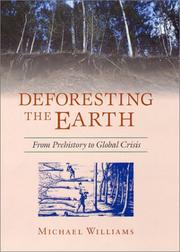
ISBN: 0226899268 Year: 2003 Publisher: Chicago (Ill.): University of Chicago press
Abstract | Keywords | Export | Availability | Bookmark
 Loading...
Loading...Choose an application
- Reference Manager
- EndNote
- RefWorks (Direct export to RefWorks)
Clearing of land --- Deforestation --- Forests and forestry --- History. --- Forest land --- Forest lands --- Forest planting --- Forest production --- Forest sciences --- Forestation --- Forested lands --- Forestland --- Forestlands --- Forestry --- Forestry industry --- Forestry sciences --- Land, Forest --- Lands, Forest --- Silviculture --- Sylviculture --- Woodlands --- Woods (Forests) --- Agriculture --- Natural resources --- Afforestation --- Arboriculture --- Logging --- Timber --- Tree crops --- Trees --- Conversion, Forest --- Depletion of forests --- Disforestation --- Forest conversion --- Forest depletion --- Forest-land conversion --- Forest fires --- Plants --- Land clearing --- Reclamation of land --- History --- Extinction
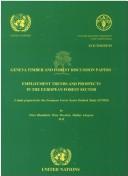
ISBN: 9211168430 9789211168433 Year: 2003 Volume: *6 Publisher: New York and Geneva United Nations
Abstract | Keywords | Export | Availability | Bookmark
 Loading...
Loading...Choose an application
- Reference Manager
- EndNote
- RefWorks (Direct export to RefWorks)
Forests and forestry --- Forest products industry --- Sustainable forestry --- Forest productivity, Maintenance of long-term --- Long-term forest productivity, Maintenance of --- Maintenance of long-term forest productivity --- Sustainable agriculture --- Forest industries --- Forestry industry --- Wood products industry --- Wood-using industries --- Plant products industry --- Forest land --- Forest lands --- Forest planting --- Forest production --- Forest sciences --- Forestation --- Forested lands --- Forestland --- Forestlands --- Forestry --- Forestry sciences --- Land, Forest --- Lands, Forest --- Silviculture --- Sylviculture --- Woodlands --- Woods (Forests) --- Agriculture --- Natural resources --- Afforestation --- Arboriculture --- Logging --- Timber --- Tree crops --- Trees --- Employees --- Supply and demand --- Economic aspects
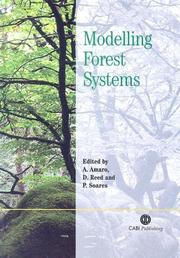
ISBN: 0851996930 Year: 2003 Publisher: Wallingford : CABI Publishing,
Abstract | Keywords | Export | Availability | Bookmark
 Loading...
Loading...Choose an application
- Reference Manager
- EndNote
- RefWorks (Direct export to RefWorks)
forests --- Plantation forestière --- Forest plantations --- Croissance --- Growth --- Aménagement forestier --- Forest management --- Production forestière --- Forestry production --- Modèle --- Models --- Forest ecology --- Forests and forestry --- Forest land --- Forest lands --- Forest planting --- Forest production --- Forest sciences --- Forestation --- Forested lands --- Forestland --- Forestlands --- Forestry --- Forestry industry --- Forestry sciences --- Land, Forest --- Lands, Forest --- Silviculture --- Sylviculture --- Woodlands --- Woods (Forests) --- Agriculture --- Natural resources --- Afforestation --- Arboriculture --- Logging --- Timber --- Tree crops --- Trees --- Forest administration --- Forest plants --- Forest resource administration --- Forest resource management --- Forest stewardship --- Forest vegetation management --- Forestry management --- Stewardship, Forest --- Vegetation management, Forest --- Ecosystem management --- Ecology --- Mathematical models --- Management --- Administration --- Control --- Forest ecosystems
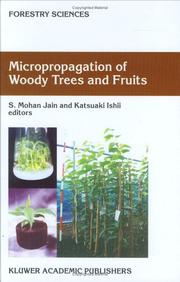
ISBN: 1402011350 940103964X 9401001251 Year: 2003 Publisher: Dordrecht ; Boston : Kluwer Academic Publishers,
Abstract | Keywords | Export | Availability | Bookmark
 Loading...
Loading...Choose an application
- Reference Manager
- EndNote
- RefWorks (Direct export to RefWorks)
Global warming, environmental changes, water shortage, and sustainable development are the most up-to-date issues, which have challenged mankind. Researchers worldwide are engaged in addressing some of these problems, including reduction in carbon dioxide accumulation, and enrichment of perennial woody species on the terrestrial ecosystem. About 12 million hectares of the world's forests disappear every year. By 2025, the world population will reach 7. 5 billion, and the forest area will be reduced to well below 50 % of the current area. Reforestation is an important to prevent the loss of forest resources including timber, biodiversity and water resources. Therefore, subsequent volume of reforestation over the deforested land should be followed to safeguard the forests and maintain its size, which will require a continuous supply of planting material. Similarly fruit trees, including tropical and subtropical fruit trees, are consumed both as fresh and in the processed form including juices, beverages, and dried fruits. They are an important source of nutrition e. g. rich in vitamins, sugars, aromas and flavour compounds, and raw material for food processing industries. The production, cultivation and maintenance of tree species provide highly sustainable production systems that conserve soils, microenvironment and biodiversity. Fruit trees have longjuvenile periods and large tree size. In many fruit trees e. g. avocado and others controlled crosses are difficult to make due to massive fruit drop.
Fruit --- Trees --- Woody plants --- Basic Sciences. Biotechnology --- Micropropagation. --- Plant genetics. --- Forestry. --- Plant science. --- Botany. --- Biochemistry. --- Trees. --- Plant Genetics and Genomics. --- Science, Humanities and Social Sciences, multidisciplinary. --- Plant Sciences. --- Biochemistry, general. --- Tree Biology. --- Dendrology --- Nursery stock --- Arboriculture --- Forests and forestry --- Timber --- Biological chemistry --- Chemical composition of organisms --- Organisms --- Physiological chemistry --- Biology --- Chemistry --- Medical sciences --- Botanical science --- Phytobiology --- Phytography --- Phytology --- Plant biology --- Plant science --- Natural history --- Plants --- Forest land --- Forest lands --- Forest planting --- Forest production --- Forest sciences --- Forestation --- Forested lands --- Forestland --- Forestlands --- Forestry --- Forestry industry --- Forestry sciences --- Land, Forest --- Lands, Forest --- Silviculture --- Sylviculture --- Woodlands --- Woods (Forests) --- Agriculture --- Natural resources --- Afforestation --- Logging --- Tree crops --- Genetics --- Composition --- Floristic botany
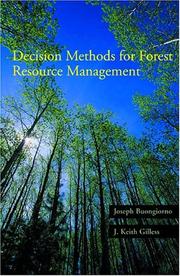
ISBN: 1281004995 9786611004996 0080491049 9780080491042 9781281004994 0121413608 9780121413606 Year: 2003 Publisher: Amsterdam : Academic Press ELSEVIER,
Abstract | Keywords | Export | Availability | Bookmark
 Loading...
Loading...Choose an application
- Reference Manager
- EndNote
- RefWorks (Direct export to RefWorks)
Decision Methods for Forest Resource Management focuses on decision making for forests that are managed for both ecological and economic objectives. The essential modern decision methods used in the scientific management of forests are described using basic algebra, computer spreadsheets, and numerous examples and applications. Balanced treatment is given throughout the book to the ecological and economic impacts of alternative management decisions in both even-aged and uneven-aged forests.* In-depth coverage of both ecological and economic issues* Hands-on examples with Excel sp
Forest management --- Forests and forestry. --- Forest land --- Forest lands --- Forest planting --- Forest production --- Forest sciences --- Forestation --- Forested lands --- Forestland --- Forestlands --- Forestry --- Forestry industry --- Forestry sciences --- Land, Forest --- Lands, Forest --- Silviculture --- Sylviculture --- Woodlands --- Woods (Forests) --- Agriculture --- Natural resources --- Afforestation --- Arboriculture --- Logging --- Timber --- Tree crops --- Trees --- Forest administration --- Forest plants --- Forest resource administration --- Forest resource management --- Forest stewardship --- Forest vegetation management --- Forestry management --- Forests and forestry --- Stewardship, Forest --- Vegetation management, Forest --- Ecosystem management --- Decision making. --- Management --- Administration --- Control --- Forest resources --- Decision making --- computer applications --- Linear programming --- Management by objectives
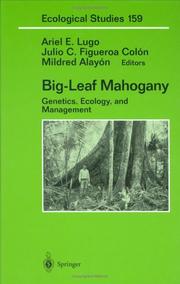
ISBN: 1280188820 9786610188826 0387217789 0387988378 Year: 2003 Publisher: New York, NY : Springer New York : Imprint: Springer,
Abstract | Keywords | Export | Availability | Bookmark
 Loading...
Loading...Choose an application
- Reference Manager
- EndNote
- RefWorks (Direct export to RefWorks)
Big-Leaf Mahogany is the most important commercial timber species of the tropics. Current debate concerning whether to protect it as an endangered species has been hampered by the lack of complete, definitive scientific documentation. This book reports on vital research on the ecology of big-leaf mahogany, including genetic variations, regeneration, natural distribution patterns and the silvicutural and trade implications for the tree.
Electronic books. -- local. --- Honduras mahogany. --- Mahogany. --- Honduras mahogany --- Earth & Environmental Sciences --- Botany --- Plant Ecology --- Forestry --- Issue --- Life sciences. --- Plant ecology. --- Forestry. --- Plant genetics. --- Nature conservation. --- Life Sciences. --- Plant Ecology. --- Plant Genetics & Genomics. --- Plant Systematics/Taxonomy/Biogeography. --- Nature Conservation. --- Forests and forestry. --- Plant Genetics and Genomics. --- Plant systematics. --- Plant taxonomy. --- Conservation of nature --- Nature --- Nature protection --- Protection of nature --- Conservation of natural resources --- Applied ecology --- Conservation biology --- Endangered ecosystems --- Natural areas --- Botanical classification --- Botanical systematics --- Botanical taxonomy --- Classification --- Plant biosystematics --- Plant classification --- Plant systematics --- Plant taxonomy --- Systematic botany --- Systematics (Botany) --- Taxonomy, Plant --- Plant taxonomists --- Plants --- Genetics --- Forest land --- Forest lands --- Forest planting --- Forest production --- Forest sciences --- Forestation --- Forested lands --- Forestland --- Forestlands --- Forestry industry --- Forestry sciences --- Land, Forest --- Lands, Forest --- Silviculture --- Sylviculture --- Woodlands --- Woods (Forests) --- Agriculture --- Natural resources --- Afforestation --- Arboriculture --- Logging --- Timber --- Tree crops --- Trees --- Phytoecology --- Vegetation ecology --- Ecology --- Conservation --- Big-leaf mahogany --- Swietenia macrophylla --- Mahogany --- Conservation biology. --- Ecology. --- Plant Genetics. --- Plant Evolution. --- Conservation Biology. --- Evolution.

ISBN: 3540438408 3642078605 3662089866 Year: 2003 Publisher: Berlin : Springer,
Abstract | Keywords | Export | Availability | Bookmark
 Loading...
Loading...Choose an application
- Reference Manager
- EndNote
- RefWorks (Direct export to RefWorks)
The subject of nondestructive evaluation of wood properties has its origin in the necessity to solve practical problems. This book comprehensively reviews numerous aspects of imaging and nondestructive characterization of wood products ranging from trees to the most complex wood-based composite. The text is of particular interest to those who are concerned with the study of wood as an engineering material for fundamental research or practical application. It presents the imaging of the internal structure of wood with methods based on the propagation of electromagnetic waves, elastic waves and heat, and imaging with nuclear particle radiation based methods.
dendrology --- techniques --- testing --- wood --- Environmental Sciences and Forestry. Forestry -- Forest Products -- Wood and Wood Products --- Nondestructive testing. --- Wood --- ALLW. --- Testing. --- Nondestructive testing --- Timber --- Evaluation, Nondestructive --- Materials --- NDE (Testing) --- NDT (Testing) --- Non-destructive testing --- Nondestructive evaluation --- Testing --- Materials science. --- Forest products. --- Forestry. --- Acoustics. --- Plant anatomy. --- Plant development. --- Materials Science, general. --- Wood Science & Technology. --- Plant Anatomy/Development. --- Development of plants --- Plant development --- Developmental biology --- Growth (Plants) --- Plants --- Botany --- Plant structure --- Structural botany --- Vegetable anatomy --- Anatomy --- Forest land --- Forest lands --- Forest planting --- Forest production --- Forest sciences --- Forestation --- Forested lands --- Forestland --- Forestlands --- Forestry --- Forestry industry --- Forestry sciences --- Land, Forest --- Lands, Forest --- Silviculture --- Sylviculture --- Woodlands --- Woods (Forests) --- Agriculture --- Natural resources --- Afforestation --- Arboriculture --- Logging --- Tree crops --- Trees --- Botany, Economic --- Commercial products --- Raw materials --- Material science --- Physical sciences --- Ontogeny --- Structure --- WOOD --- NONDESTRUCTIVE TESTS --- TESTING
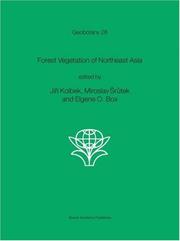
ISBN: 1402013701 9048163129 9401701431 Year: 2003 Publisher: Dordrecht : Springer Netherlands : Imprint: Springer,
Abstract | Keywords | Export | Availability | Bookmark
 Loading...
Loading...Choose an application
- Reference Manager
- EndNote
- RefWorks (Direct export to RefWorks)
When two of us (Jifi Kolbek, Miroslav Sriltek) were working in North Korea on the Czech Slovak field expeditions of the early 1990s, we did not think initially of comparing our results with the vegetation of surrounding areas or of writing a book. Our efforts mainly involved observing and documenting the vegetation as completely as possible and initial recognition of vegetation units. At first we focused on the most obvious vegetation types, but eventually also any important types that we could discern. Later we focused more on forests, since almost ali of northeastern Asia has forest potential and forests stiH do form the landscape matrix in most areas. First we studied suburban woods and forests, most of which are strongly affected by human activities. Later, though, we also had chances to visit and study lovely mountain regions, including Myohyang-san, Kumgang-san, Su jang-san, and the high, especially beautiful Changbai-shan on the border between North Korea and China. The Changbai-shan is the highest mountain system in the Korean Peninsula, including the highest peak Paektu-san. We gradually changed our goal from an evaluation of forest data from North Korea to comparison with available field data and literature sources from comparable surrounding areas. These include South Korea, the Russian Far East, northeastern China (Manchuria), and northem Japan, including the Kuril Islands. Finally we decided to prepare a preliminary survey of the forest vegetation of the Russian Far East and eventually of aII of northeastem Asia, which would be published in English.
Eastern Asia --- Asia --- forest ecology --- forest vegetation --- phytogeography --- Plant science. --- Botany. --- Plant systematics. --- Plant taxonomy. --- Forestry. --- Trees. --- Statistics . --- Plant Sciences. --- Plant Systematics/Taxonomy/Biogeography. --- Tree Biology. --- Statistics for Engineering, Physics, Computer Science, Chemistry and Earth Sciences. --- Statistical analysis --- Statistical data --- Statistical methods --- Statistical science --- Mathematics --- Econometrics --- Dendrology --- Nursery stock --- Woody plants --- Arboriculture --- Forests and forestry --- Timber --- Forest land --- Forest lands --- Forest planting --- Forest production --- Forest sciences --- Forestation --- Forested lands --- Forestland --- Forestlands --- Forestry --- Forestry industry --- Forestry sciences --- Land, Forest --- Lands, Forest --- Silviculture --- Sylviculture --- Woodlands --- Woods (Forests) --- Agriculture --- Natural resources --- Afforestation --- Logging --- Tree crops --- Trees --- Botanical classification --- Botanical systematics --- Botanical taxonomy --- Botany --- Classification --- Plant biosystematics --- Plant classification --- Plant systematics --- Plant taxonomy --- Systematic botany --- Systematics (Botany) --- Taxonomy, Plant --- Plant taxonomists --- Botanical science --- Phytobiology --- Phytography --- Phytology --- Plant biology --- Plant science --- Biology --- Natural history --- Plants --- Floristic botany
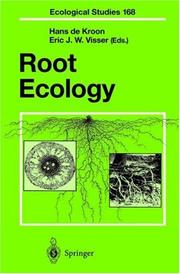
ISSN: 00708356 ISBN: 3540001859 3642055206 3662097842 9783540001850 Year: 2003 Volume: 168 Publisher: Berlin Springer
Abstract | Keywords | Export | Availability | Bookmark
 Loading...
Loading...Choose an application
- Reference Manager
- EndNote
- RefWorks (Direct export to RefWorks)
In the course of evolution, a great variety of root systems have learned to overcome the many physical, biochemical and biological problems brought about by soil. This development has made them a fascinating object of scientific study. This volume gives an overview of how roots have adapted to the soil environment and which roles they play in the soil ecosystem. The text describes the form and function of roots, their temporal and spatial distribution, and their turnover rate in various ecosystems. Subsequently, a physiological background is provided for basic functions, such as carbon acquisition, water and solute movement, and for their responses to three major abiotic stresses, i.e. hard soil structure, drought and flooding. The volume concludes with the interactions of roots with other organisms of the complex soil ecosystem, including symbiosis, competition, and the function of roots as a food source.
Plant ecology. Plant sociology --- Phytomorphology. Phytoanatomy --- Plant physiology. Plant biophysics --- Roots (Botany) --- Ecology. --- 581.144.2 --- 581.557.24 --- 579.841.3 --- 631.46 --- -Plant ecology --- Soil ecology --- Roots. Subterranean nutrition organs --- Mycorrhiza --- Rhizobiaceae --- Soil bacteriology. Soil biology --- Ecology --- -Roots. Subterranean nutrition organs --- 631.46 Soil bacteriology. Soil biology --- 579.841.3 Rhizobiaceae --- 581.557.24 Mycorrhiza --- 581.144.2 Roots. Subterranean nutrition organs --- -631.46 Soil bacteriology. Soil biology --- Plant ecology --- Ecology . --- Agriculture. --- Forestry. --- Plant science. --- Botany. --- Plant physiology. --- Plant Sciences. --- Plant Physiology. --- Botany --- Plants --- Physiology --- Botanical science --- Phytobiology --- Phytography --- Phytology --- Plant biology --- Plant science --- Biology --- Natural history --- Forest land --- Forest lands --- Forest planting --- Forest production --- Forest sciences --- Forestation --- Forested lands --- Forestland --- Forestlands --- Forestry --- Forestry industry --- Forestry sciences --- Land, Forest --- Lands, Forest --- Silviculture --- Sylviculture --- Woodlands --- Woods (Forests) --- Agriculture --- Natural resources --- Afforestation --- Arboriculture --- Logging --- Timber --- Tree crops --- Trees --- Farming --- Husbandry --- Industrial arts --- Life sciences --- Food supply --- Land use, Rural --- Balance of nature --- Bionomics --- Ecological processes --- Ecological science --- Ecological sciences --- Environment --- Environmental biology --- Oecology --- Environmental sciences --- Population biology --- Floristic botany --- Roots (Botany) - Ecology
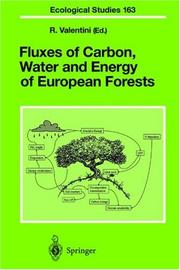
ISSN: 00708356 ISBN: 3540437916 3642078486 3662051710 9783540437918 Year: 2003 Volume: 163 Publisher: Berlin : Springer,
Abstract | Keywords | Export | Availability | Bookmark
 Loading...
Loading...Choose an application
- Reference Manager
- EndNote
- RefWorks (Direct export to RefWorks)
After years of technological development and its important achievements to make our life easier and more comfortable, human society is going to face one of the most difficult challenges of the last century: to stabilize the concentra tion levels of greenhouse gases in the atmosphere to prevent harmful effects on the climate system. Through a delicate balance between photosynthesis and respiration, terres trial ecosystems, and in particular forests, are today thought to take up a sig nificant part of the carbon dioxide emissions in the atmosphere, sometimes called the "terrestrial carbon sink". However, the location, magnitude, and vulnerability of the carbon dioxide sink of the terrestrial biota are still uncer tain. The suite of traditional tools in an ecologist's toolbox for studying ecosys tem productivity and carbon balance include leaf cuvettes, whole-plant and soil chambers for gas exchange, and biomass and soil carbon inventories. While each of the cited methods has distinct advantages, they are limited with regards to their ability to measure net carbon dioxide exchange of the whole ecosystem across a variety of time scales. This book present a compendium of results of a European project (EURO FLUX), funded by the European Commission through its fourth framework program, aiming to elucidate the role of forests in continental carbon balance.
Plant ecology. Plant sociology --- Geochemistry --- Forestry --- Europe --- forests --- Dioxyde de carbone --- carbon dioxide --- water --- Rayonnement thermique --- Thermal radiation --- Cycle biogéochimique --- cycling --- Relation source puits --- Source sink relations --- Modèle dynamique --- Dynamic models --- Carbon cycle (Biogeochemistry) --- -630*18 --- Forest ecology --- -Forests and forestry --- Ecology --- Global carbon cycle --- Biogeochemical cycles --- Plant ecology --- Environmental Sciences and Forestry. Forestry --- Forest Ecology --- Forest Ecology. --- -Plant ecology --- 630*18 Plant ecology --- -630*18 Plant ecology --- Forests and forestry --- 630*18 --- Forest ecosystems --- Forestry. --- Ecology . --- Geoecology. --- Environmental geology. --- Air pollution. --- Nature conservation. --- Climate change. --- Terrestial Ecology. --- Geoecology/Natural Processes. --- Atmospheric Protection/Air Quality Control/Air Pollution. --- Nature Conservation. --- Climate Change. --- Changes, Climatic --- Changes in climate --- Climate change --- Climate change science --- Climate changes --- Climate variations --- Climatic change --- Climatic changes --- Climatic fluctuations --- Climatic variations --- Global climate changes --- Global climatic changes --- Climatology --- Climate change mitigation --- Teleconnections (Climatology) --- Conservation of nature --- Nature --- Nature protection --- Protection of nature --- Conservation of natural resources --- Applied ecology --- Conservation biology --- Endangered ecosystems --- Natural areas --- Air --- Air contaminants --- Air pollutants --- Air pollution --- Air pollution control --- Air toxics --- Airborne pollutants --- Atmosphere --- Contaminants, Air --- Control of air pollution --- Pollutants, Air --- Toxics, Air --- Pollution --- Air quality --- Atmospheric deposition --- Geoecology --- Environmental protection --- Physical geology --- Balance of nature --- Biology --- Bionomics --- Ecological processes --- Ecological science --- Ecological sciences --- Environment --- Environmental biology --- Oecology --- Environmental sciences --- Population biology --- Forest land --- Forest lands --- Forest planting --- Forest production --- Forest sciences --- Forestation --- Forested lands --- Forestland --- Forestlands --- Forestry industry --- Forestry sciences --- Land, Forest --- Lands, Forest --- Silviculture --- Sylviculture --- Woodlands --- Woods (Forests) --- Agriculture --- Natural resources --- Afforestation --- Arboriculture --- Logging --- Timber --- Tree crops --- Trees --- Environmental aspects --- Conservation --- Control --- Carbon cycle (Biogeochemistry) - Europe --- Forest ecology - Europe
| Listing 1 - 10 of 10 |
Sort by
|

 Search
Search Feedback
Feedback About
About Help
Help News
News